Saturday 20th June 2020
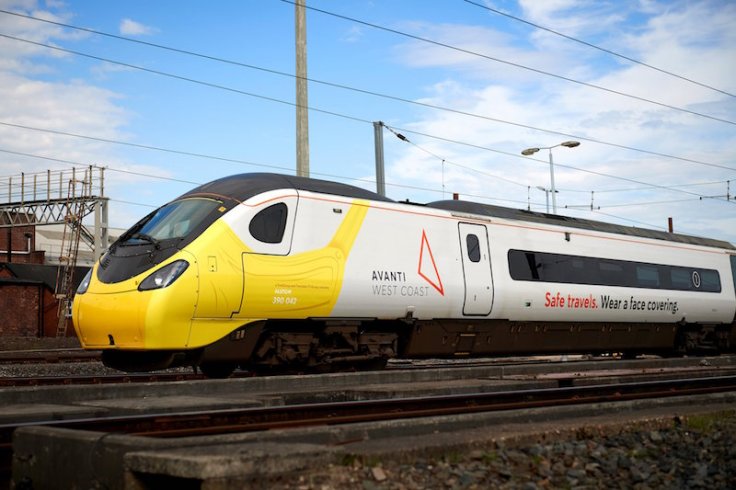
Week 13 was to be a milestone week. Remember this from 19th March? “I do think, looking at it all, that we can turn the tide within the next 12 weeks, and I am absolutely confident we can send coronavirus packing in this country”.
How lucky the Alert level was reduced from 4 to 3 Just in the nick of time on Friday. It means “the virus is in general circulation” but transmission is no longer “high or rising exponentially”. The R rate remains stubbornly “between 0.7 and 0.9”. The tide may be turning but there’s no sign it’s packed its bags just yet.
But never mind all that, the main excitement of week 13 was seeing Primark devotees out in force celebrating England’s non essential shops much heralded reopening on Monday. But it was a damp squib for any discernible increase in demand for public transport.
Trains, trams and buses continued to mostly carry tumbleweed supplemented by the odd passenger (now all mandated to wear face coverings in England) at continued great expense to the taxpayer. But minimal loadings are just as well bearing in mind continued capacity constraints.
I keep thinking about the last few decades seeing so many lost services for a lack of passengers and if only we’d been as relaxed about the cost of those empty bus seats trundling around rural and suburban roads and fresh air filled trains gliding along tracks in the 1960s and 1970s as we seemingly are during this ‘unprecedented period’ when ‘whatever it takes’ is the official mantra; then we really would have a ‘world beating’ public transport system of which to be proud. So why are us public transport fans getting so concerned at looming storm clouds? Answer: because we all know ‘whatever it takes’ isn’t going to last much longer. Either social distancing is going to have to give and passengers told they can (and must!) travel again; or services will have to be cut to reduce the financial burden.
And we all know ‘2 metres’ is now on ‘borrowed time’ bearing in mind it’s under a PM inspired ‘official review’. There’ll be the usual eleventh hour announcement, no doubt, rendering hundreds of thousands, if not millions, of notices redundant. Get those ‘1 metre’ over stickers at the ready.
It was pointed out this week it’s costing a £100 for every rail passenger travelling since lockdown began on 23rd March with no sign of a let up in this hideous cost with all efforts possible continuing to discourage anyone to actually make a journey on a train.
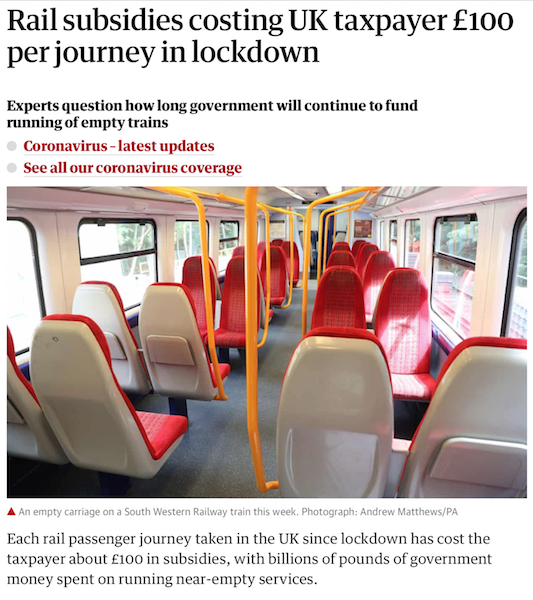
As you read the dire warnings on one train company’s website after another …..
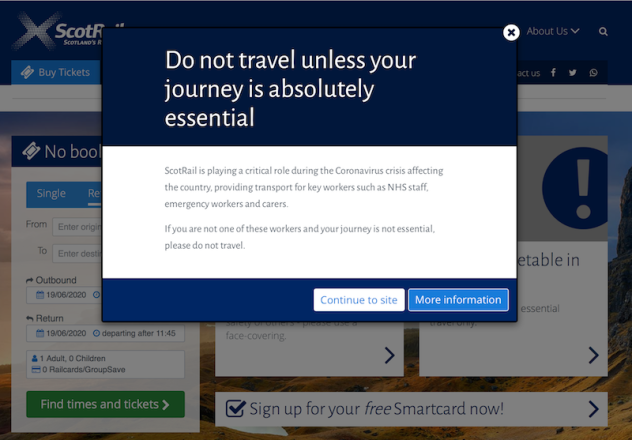

…. you have to wonder whether it might be coming to the time when it’s better to mothball the whole system and pay for an individual taxi for the few passengers still travelling. It’s a provocative suggestion which I made a few weeks back in this blog – only half seriously as I know it’s not practical nor desirable. But neither does it make sense to be running taxi type loads on full length trains at such huge financial cost.
Twenty transport highlights from this week include:
1. EasyJet restarted its Gatwick/Glasgow service on Monday. Face coverings are mandated but no capacity constraining social distancing seat restrictions and no surprise their website’s not imploring you to drive, cycle or walk as an alternative to giving them your custom.

2. Mayor Khan announced the London congestion charge increases this coming Monday to £15 and will apply for extended hours from 07:00 to 22:00 as part of the deal insisted upon by DfT (as the Mayor insisted on reminding us).
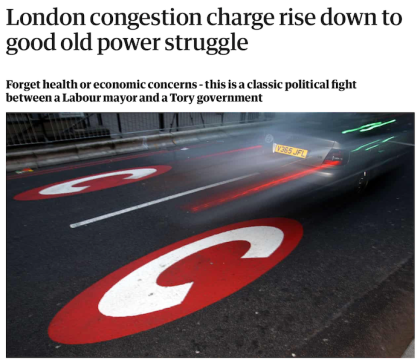
3. I didn’t see it announced anywhere, but as I have a stash in my desk drawer from last years delay repay experiences, I was relieved to hear rail voucher validity has been extended by six months.
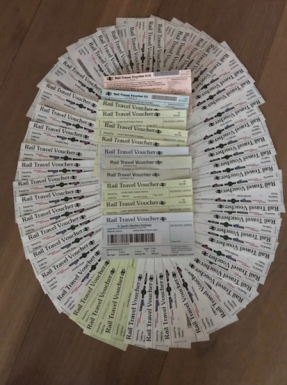
4. 500 hand sanitising units have been installed at TfL’s stations and bus stations.

5. Face coverings become mandatory on public transport in Scotland from Monday. That sorts the LNER/Cross Country/TPE and Avanti West Coast cross border anomaly out.

6. It’s been back to morning peak time restrictions for concessionary travel in most areas this week including a new restriction in London for Freedom Pass holders before 09:00 on Mondays to Fridays but it’s a three click process on the TfL website to find that out.
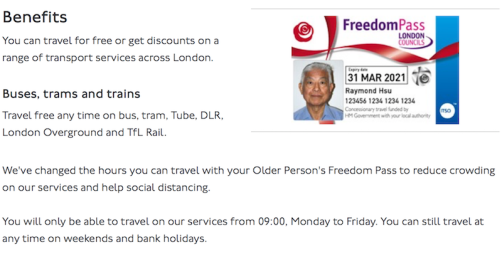
7. Transdev Blazefield started selling a smart £4.50 on brand face mask in their online shop on Monday with proceeds going to NHS Charities Together. Buy yours here. I did. A great initiative.

8. Transport Focus asked the Rail Delivery Group to extend railcard expiry dates or offer a renewal discount to reflect the months of discounts lost by passengers not being able to travel; (good one TF). That’ll have to be referred up to the DfT for a decision, of course. They might just agree to it though, and save it up for one of Grant’s ‘today I can announce’ briefing speeches to divert attention from some other failure or disaster.
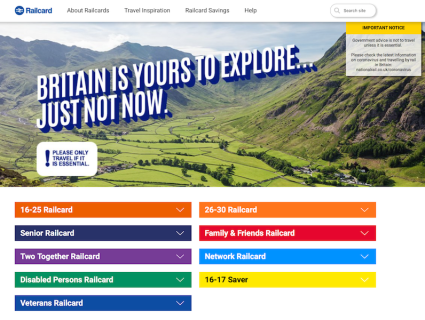
9. The DfT stepped up its campaign against public transport on Wednesday by tweeting that as car showrooms are now back open “there’s never been a better time to switch to electric” with an embedded video exalting us all to go out and buy a car. You can watch it here.
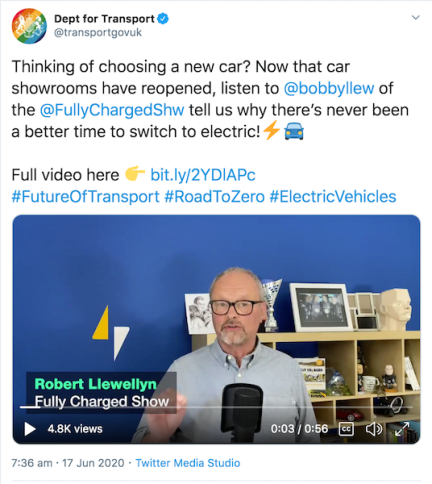
10. Ensignbus reported on Tuesday a passenger was fined that morning for refusing to wear a face covering without good reason warning: “the Police are now actively enforcing the wearing of face coverings on public transport with £100 on the spot fines”. No other such reports were received.
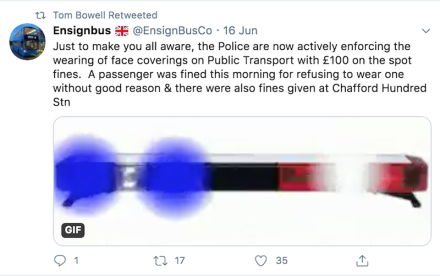
11. You’re now forced to sit even further away from being able to pretend to drive a DLR train due to new barriers installed at the ends of each train.

12. First Bus enhanced their App on Thursday to include details of wheelchair space occupancy. That’ll be useful and I’m sure will be much welcomed by wheelchair users as they keep their fingers crossed another wheelchair user doesn’t nip on the bus at the stop before theirs.
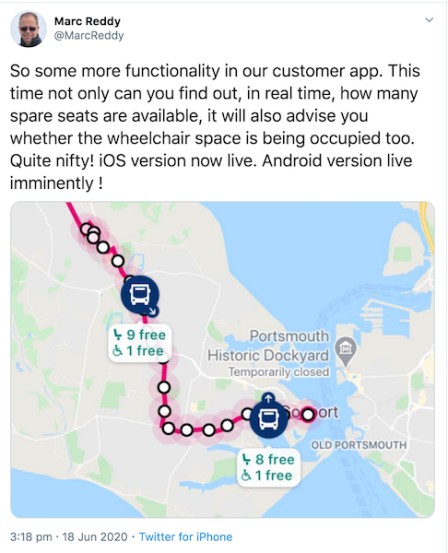
13. Sadly wheelchair users wanting to board a bus in Watford’s High Street are now unable to use the not-so-long-ago-installed level boarding arrangements thanks to Watford Borough Council plonking planters here even where the pavement is already nicely socially distanced wide. Thanks for the photo to Sullivan Buses.

14. Gold star to rural bus driver and information poster Paul Wood at Reliance Buses for his great work updating roadside timetables. More of this by other companies please.
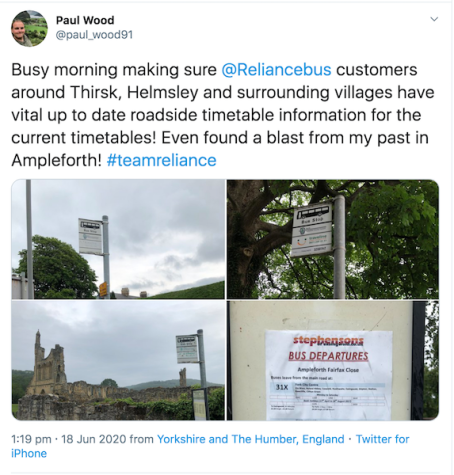
15. No stars to Metrobus for covering up timetables now back in operation as normal in Tunbridge Wells.

16. Transport Focus added two new questions to their weekly tracking survey this week. 92% agreed with the statement: “As more people start to use public transport, I don’t think social distancing (2 metres) will always be possible” while 61% “agree face coverings will improve feelings of safety”.
17. National Express coaches are gearing up for their restart on Wednesday 1st July issuing a media release to reassure passengers about the enhanced cleaning regimes, additional air filters, 50% on board capacity, temperature screening and new protective screens on board. All good but accompanied by a supposedly reassuring photograph. I looked in the FAQs for the “If I don’t have a hazmat suit; will I still be able to travel?” but couldn’t find the answer. I still think this type of visual ‘reassurance’ does more harm than good; reinforcing passenger percepations of unsafe vehicles and fears of catching something on board.
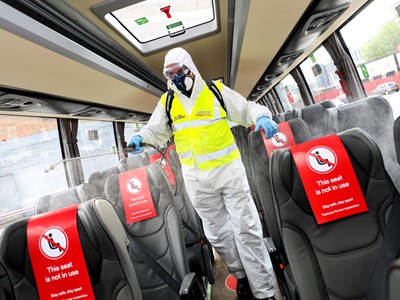
This is much more positive….

Definitely more of the ‘welcoming back’ and less of the ‘hazmat suits’ please.
18. Greater Anglia are now using a traffic light system to indicate how busy peak hour journeys are across their network on their website. Simple and effective.

19. On Friday Go North East introduced a new range of tickets to help people who work part-time and those working more flexibly. “We recognise that some workplaces are still not fully open and social distancing remains in place, so a new range of Flexi 5 tickets have been introduced to cater for the more flexible style of working the region is seeing at the moment.” Flexi 5 allows passengers to buy a ticket for the usual price of a weekly ticket but split it over any 5 individual days with up to a month to use them. What a great idea. Well done GNE.

This is another great example of the deregulated commercial bus industry at its best – reacting to changes in passenger demand “at lightening speed” and delivering the results. Can you imagine a Combined Authority controlled bus network, or TfL or the RDG or a DfT controlled rail network coming up with something so appropriate and introducing it so quickly? By the way, why hasn’t the promised National Rail fares reform been introduced during the last 13 weeks? It’s just the obvious and ideal time to do so while passenger numbers are so low. I rest my case.
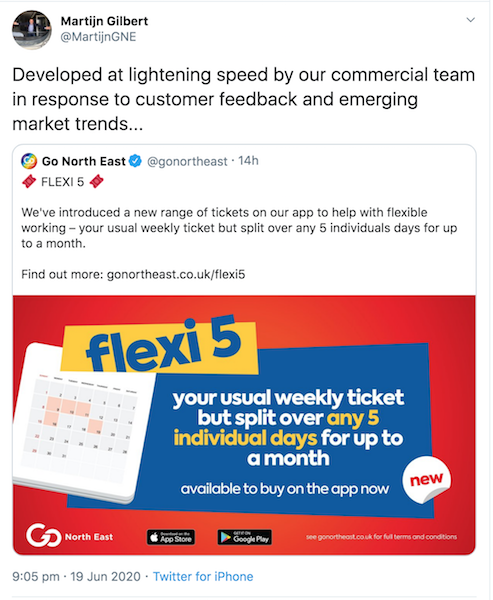
Well done Martijn and team, leading the way again.
20. From today TfL are changing 60 routes back to fare paying buses with boarding through the front door: 18, 22, 24, 27, 51, 60, 64, 65, 66, 71, 79, 85, 103, 111, 116, 126, 132, 139, 159, 164, 166, 183, 194, 198, 214, 225, 250, 255, 264, 281, 285, 289, 306, 312, 325, 346, 347, 370, 375, 406, 410, 412, 423, 444, 466, 493, 671, 681, 698, H37, H91, H98, N18, N22,
N250, N27, N65, P12, R2 & R9.
This leaves just 50 freebie middle door boarding routes left to convert, presumably next Saturday: 5, 39, 80, 93, 101, 108, 127, 129, 131, 151, 152, 154, 163, 170, 178, 180, 200, 203, 213, 219, 227, 232, 244, 246, 276, 280, 286, 300, 321, 355, 357, 358, 359, 365, 376, 378, 386, 396, 403, 432, 436, 455, 476, 485, 486, 508, 575, 718, B11, B16, D7, H13 & H32.
(In other TfL bus (non Covid-related) news, Go Ahead London are introducing eleven brand new BYD/Alexander Dennis Enviro400EV electric double deckers today on route 230 between Wood Green and Walthamstow as they take the route over from Arriva.)
A drive out
To see how things were panning out on the ground, I took an eye test style drive over to Tunbridge Wells on Tuesday morning (please note: no child in the back of the car and eyes are fine) for a look at how the new non-essential shopping regime was impacting the nine different bus operators running into the Kent town famed for its discerning letter writers as well as the myriad of bus liveries.
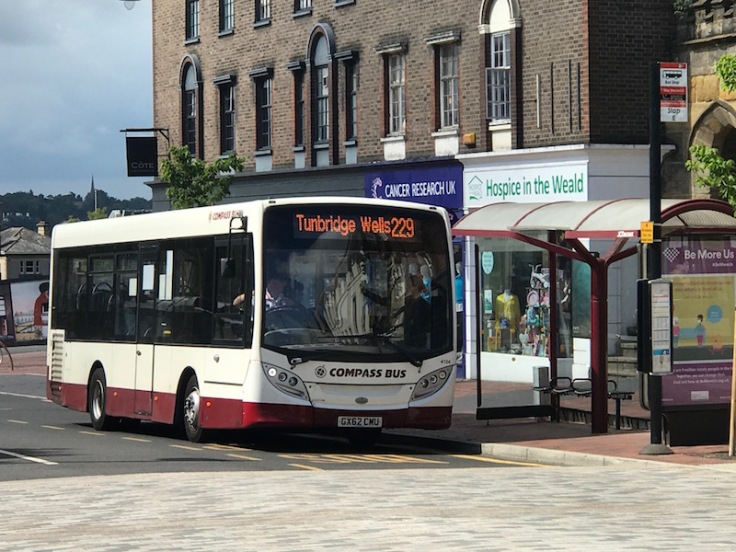
I was surprised just how quiet the town was during my visit. Mind you there’s no Primark, the nearest being in Maidstone or Crawley so perhaps everyone had headed off there.
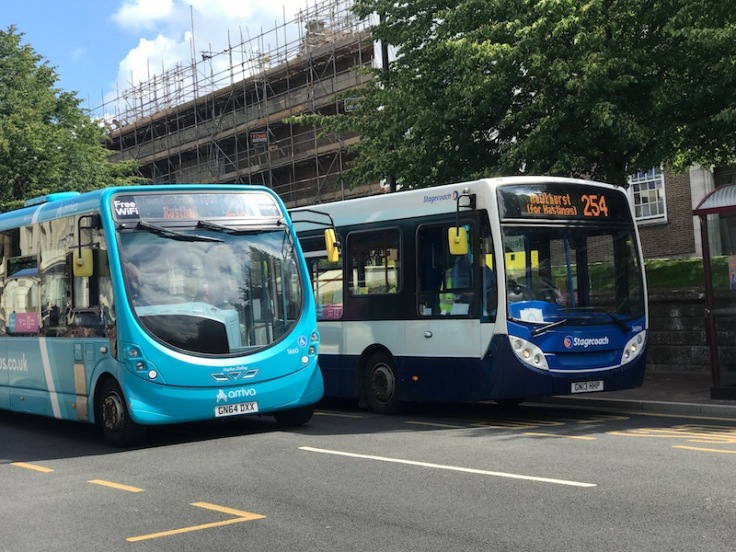
Buses were running at regular intervals on all the local and out-of-town routes with no more than half a dozen passengers on board at most.
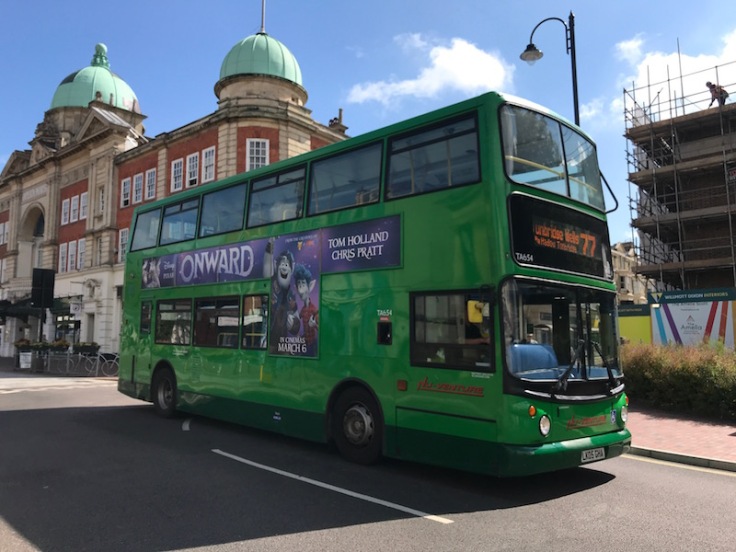
Many buses had between zero and three on board. It was remarkable for just how quiet it all was.
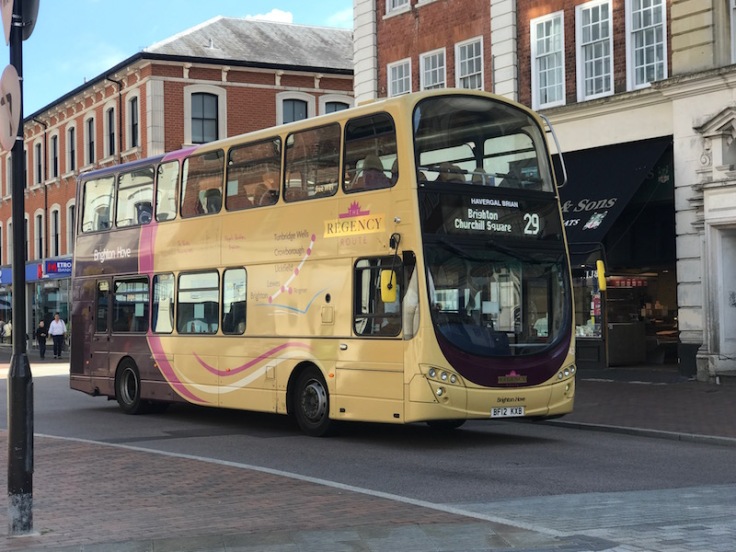
Most passengers were wearing face coverings; I spotted a couple travelling together who weren’t, but they may well have had health issues. The bus driver didn’t seem interested in them as they boarded.
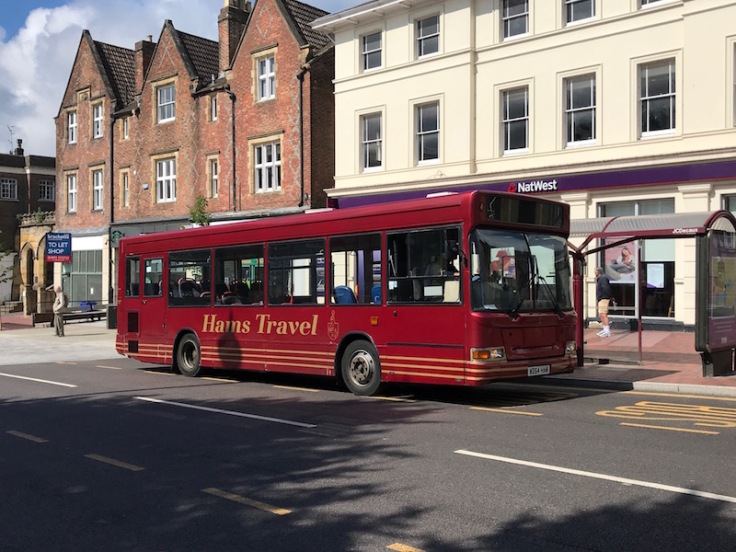
There’s no risk at the moment of passengers being left behind due to “full” buses with the current state of play. But there again, public transport isn’t performing much of a useful function either; and there’s no sense this is changing any time soon.
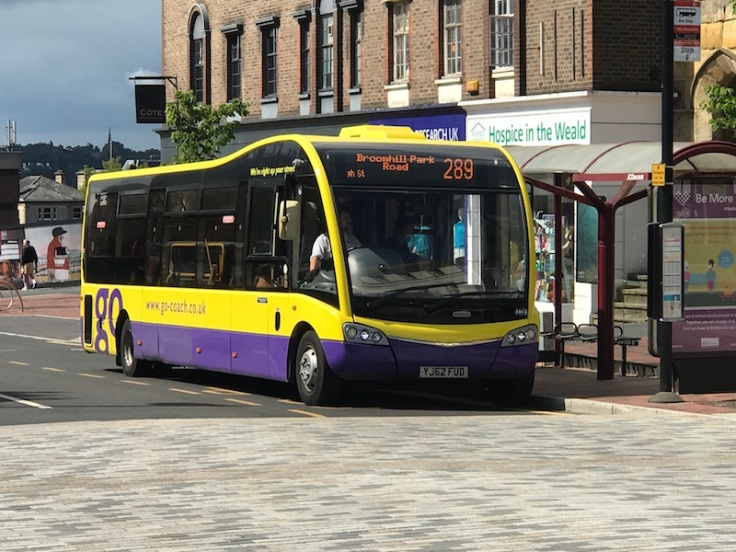
Six zoom sessions
It’s been a full on week of ‘evidence sessions‘ and forums discussing what’s happening across a tranche of transport issues. I’ve spent a happy few hours watching them, and provide a snapshot summary, so you don’t have to (but if you want to, links are in the highlighted text below).
On the other hand, fast forward down to the next section headed ‘Journey Makers update’ if you’re tight for reading time …..

London’s Deputy Mayor for Transport, Heidi Alexander (bottom left), appeared before the London Assembly’s Transport Committee on Monday passing on her effusive thanks to staff “at TfL and City Hall for their Herculean efforts. We are collectively living through one of the most astonishing periods of this City’s history. The fact we’ve kept the Tubes and buses running is testament to the 60,000 incredible men and women who work on the front line of the transport network”.
Encapsulating the weird times we’re going through, she continued: “back in March we turned an oil tanker around in a matter of hours. We went from being an organisation who’s primary purpose was to promote the use of public transport to one which told people to get off it”.
The fission between TfL and the Government on funding was exposed with Heidi Alexander adding: “I’m pleased we were able to agree a funding deal with Government to enable TfL to operate services for the next four months but I was angry and disappointed by the political conditions that were crowbarred into the agreement at the last minute. Fare income dropped by 90%. You don’t have to be a trained account to work out if fares and other commercial activity make up 80% of your day to day running budget, you’ve got a problem when you only have 10% of that coming in. Government though are insisting on higher fares next year and a removal of free travel for children and young people settling old political scores in the middle of a pandemic”.
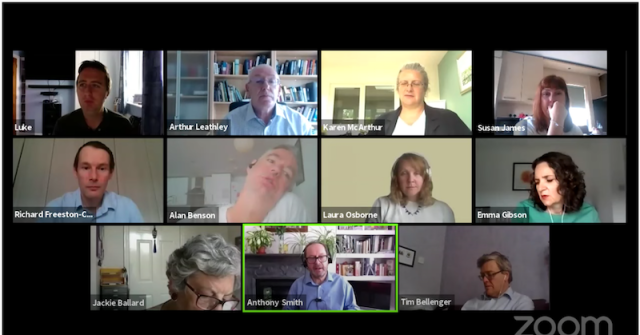
On a similar theme the next day, London Travelwatch held their board meeting on Tuesday morning and TfL’s Chief Customer Officer, Mark Evers attended and told members services were ”getting back to service levels which aren’t that far away from normal”.

He explained TfL had been running about 60% of Tube and 80% of bus services, limits constrained by the number of operational staff available. 8% of front line Underground staff are shielding and off work. “As of Monday we ran 93% of scheduled services on London Underground including a bit more in the peak. The Victoria Line had a full service of 36 trains per hour, and the bus network had 90% with the Overground, DLR and TfL Rail services at 80-90% of normal”.
Mark continued the “level of demand continues to be significantly down although it’s increasing day by day and week by week. It was 5% of normal journeys on the Tube at the height of the pandemic and was 86% down yesterday …. but we didn’t really see much growth in the peak; most growth was after 09:00 and inter-peak reflecting the opening of non essential retail”.
On buses, levels were 68% down on normal, which was an increase of 20-25% over last week.
Mark also explained TfL were seeing a “more sharper peak on the Tube whereas bus use is more flat across the day. The peak of the peak has shifted earlier to 05:45 to 07:30 reflecting many offices bring closed and workers in construction and health services now travelling”. Mark said the busiest lines were in east London, particularly Stratford, Canning Town and West Ham stations with the Central Line being busy between South Woodford and Stratford as well as the eastern end of the District and Jubilee Lines and much of the Victoria Line for a short period.
On the road network, traffic on TfL red routes has been down 17% compared to a year ago but increased by 5% last week. He observed there’ve been higher increases in traffic compared to public transport but the latter is now catching up.
While Mark acknowledged the need to protect against a ‘car led recovery’ and the need to provide as many safe public transport journeys as possible with walking and cycling he reiterated the mantra: ‘only those who need to travel should do so’ “probably for quite some time to come”.
Mark noted that until now a gradual increase in passenger journeys had been experienced but the challenge for the next few weeks is “demand will hit the tipping point of filling up the available capacity, in specific locations at specific times”. TfL have plans to manage crowds at a growing number of locations, holding people at entrances to stations as well as “thinking about running non stopping trains through hot spot locations” but acknowledged working out which stations make the most sense to skip is not easy with passengers already on board wanting to alight at the busiest stations.

Parliament’s Transport Select Committee held an evidence session on Wednesday as part of their Inquiry into ‘Coronavirus: Implications for transport’. Having previously looked at aviation, this one was on local transport and involved online interviews to gather evidence with three metro Mayors: Tim Bowles (West of England), Andy Burnham (Greater Manchester) and Steve Rotherham (Liverpool City Region). Not surprisingly these three pressed the point they wanted future Government funding to be paid directly to them rather than to bus operators so it would “give us control”.
Andy Burnham stressed “we have a unique opportunity to reform public transport outside of London”; “we all deserve a London style transport system”; which basically translated to me as ‘give us the money and let us control the buses as well as the trams’.
Time and again London was mentioned in idealistic tones with its recent cash injection of £1.6 billion (albeit including around £500 million as a loan) but I wondered if they knew London’s Deputy Mayor Heidi Alexander had told the London Assembly on Monday that “TfL’s funding model its now fundamentally broken” due to Covid and passenger numbers unlikely to fully recover.
Other interesting points from the session included Steve Rotherham pointing out no financial package had been agreed for Merseyrail admitting it was “limping along”. Oddly it’s slipped between the tracks; not being part of the DfT Emergency Measures Agreements franchise bailouts for National Rail, nor part of the later light rail and tram hand outs. The Mayors also referred to the uncertainty with the current funding packages running out in August and the lack of consultation before initiatives such as face coverings – interestingly both Rotherham and Burnham admitted they would have pressed for their compulsion much sooner as ‘one thing they’d do differently’.
According to the Mayors who were asked for updates, in Manchester tram use had risen from 11% of a normal Monday a couple of weeks ago to 15% on Monday this week, which Andy Burnham pointed out was “up to capacity” although plans were in hand to double the length of trams next week and run a 10 minute frequency. In Bristol bus use had reduced to 10% during lockdown increasing to 15% last Monday and 19% on Monday this week (largely thanks to Primark, according to photos on social media). Liverpool seemed to be at around 10% of normal use.
Andy Burnham pointed out Metrolink was losing £6 million a month which was forecast to reduce to £3 million if social distancing was changed to 1 metre but still there’d be a budget shortfall of £30 million. He referred to his previous threat to mothball the system and wouldn’t rule that out if funding beyond August remained uncertain.
Noteworthy was contrasting Mayoral attitudes towards bus companies. On a few occasions Tim Bowles referred to his ”good relationship with bus operators”, contrasting with Andy Burnham and Steve Rotherham losing no opportunity to tell the Committee they wanted “control”.
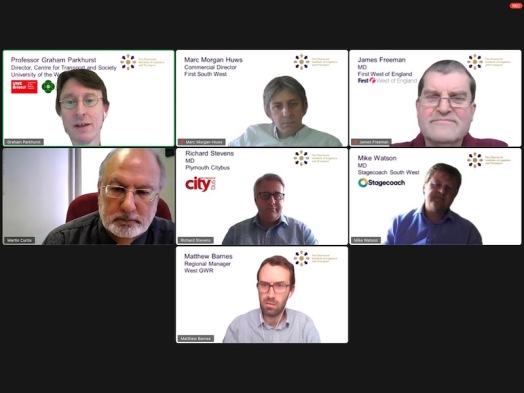
The Chartered Institute of Logistics and Transport (CILT) has also been busy this week. Its South West group held an interesting online discussion ‘The Journey to Recovery’ on Tuesday evening involving all the major bus and train operators in that area from Cornwall to Bristol. In contrast to my off peak Tunbridge Wells experience, James Freeman (First West of England) and Martin Curtis (Bath Bus Company) both spoke of “full” buses at peak times needing much duplication. This isn’t particularly sustainable either, and indeed if people do continue to return to bus travel in growing numbers providing enough capacity will prove impossible, and passengers will be driven away again through frustration at being left behind.
GWR’s Matthew Barnes referred ominously to the issue of train driver competency and training being impacted by the reduced service levels and inability to have two people in a cab due to social distancing. I got the distinct impression there’s a looming resource problem with this; and another practical explanation of why my idea of mothballing an entire train network is simply stupid. Drivers would lose their track knowledge credentials.
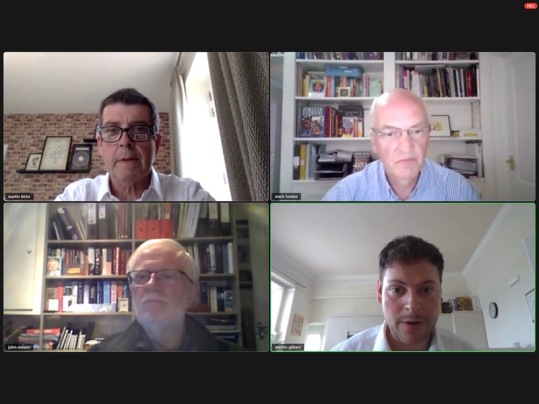
On Wednesday CILT’s Bus and Coach Forum, ably steered by Austin Birks (top left), addressed the question ‘Are leaders in the public transport industry born rather than made?’. It was a fascinating discussion which very soon landed on the experiences of the last few months and the leadership skills that had become necessary. There’s no doubt this crisis has separated out the born leaders from the made leaders with some shining examples of exemplary skills to motivate, communicate with and inspire teams of staff in the most unusual of circumstances.

On Thursday afternoon CILT’s associate organisation, PTRC, held a ‘Fireside Chat’ (don’t ask; I didn’t) on the timely theme ‘Social Distancing – The death knell for public transport?’ with yet another esteemed panel of experts addressing this vexed question. It’s a fascinating 90 minute ‘Chat’ if you have the time to watch with an avalanche of ‘chat’ comments to read if you’re very dedicated – it’s all on YouTube to view here. If you haven’t got time, trust me, the answer to the question is ‘yes’.
Journey Makers update

I promised readers an update on my continuing efforts to volunteer as a Journey Maker. You may recall this exciting initiative was announced a month ago with great gusto and enthusiasm by Transport Secretary Grant Shapps at the infamous ‘A66-dualling-don’t-mention-Cummings’ Downing Street Briefing on Saturday 23rd May. After impressing us there’ll be 3,500 British Transport Police, Network Rail and TfL employees deployed to help us keep socially distanced he added “from 1 June at the earliest we will start to deploy twice as many marshals with the assistance of groups like the charity Volunteering Matters to help produce reassurance, advice and friendly assistance to commuters”.
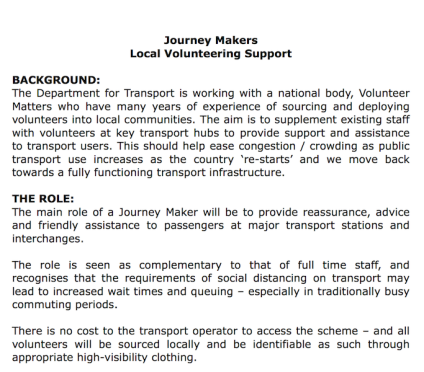
I tried contacting Volunteering Matters but their online link to the ‘Voluntary and Community Sector Emergencies Partnership’ leads through to the British Red Cross website so I filled an online form in to them receiving an email acknowledgement followed the next week by an email from Simon Lewis at the start of National Volunteers Week giving “a huge thank you for being a British Red Cross community reserve volunteer”. Having heard nothing further, the next week I rang Volunteering Matters and spoke to Mark who said he’d get someone to ring or email me back. Sadly no-one did, so on Tuesday this week I emailed them asking if someone could make contact. Still nothing, so I began thinking either they’re snowed under with volunteers or Journey Makers was just another Government initiative going the same way as the ‘game changing’ track and trace app, the PPE supplies from Turkey, the no free school meals in the holidays, the etc etc.
Then later on Tuesday a blog reading colleague in the bus industry kindly forwarded me an email he’d been copied into from his local authority which included an email from two DfT people who are co-ordinating the scheme and the above printed job description and explanation. Bingo. I dropped them an email and within half an hour had a call back from the person at Volunteering Matters who’s overseeing it all.
She explained she’s fairly new to Volunteering Matters herself and crucially the current situation is the DfT “are working on getting sign off from the trade unions”. Hmm, good luck with that. When I researched it I found the idea hasn’t gone down too well with the RMT who, true to form, are threatening strike action.
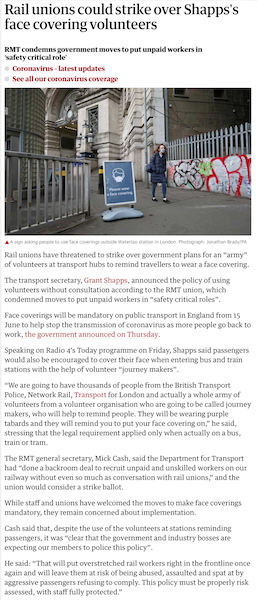
Apparently not all Train Operating Companies are signed up to the Scheme either. The other gem was I was told I’m the only person to be in contact and volunteer, so that’s one spreadsheet of contacts I’m heading up as I passed on my details together with the major stations I live near as Katy’s geographic and TOC knowledge was not particularly extensive.
Looking forward to hearing more next week. I’ve got my high-vis ready.
And in other news this week….
ScotRail promoted their plan to add bike carriages to trains on the West Highland Line with five converted Class 153 coaches. Nice idea.

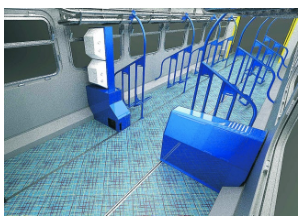
Still in that neck of the woods, steam trains are set to return with West Coast Railways announcing their plans to restart the Jacobite service between Fort William and Mallaig.
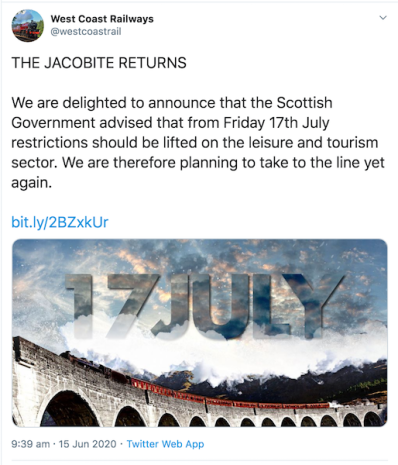
Down in Epsom, Falcon Buses (“Epsom’s Premier Bus Company”) quietly put two smart new Enviro200 MMCs into service on their Epsom bus routes. Here’s one snapped by Lewis Nagle to whom many thanks for the photo.

In South Yorkshire the long awaited Bus Review was published for Sheffield City Region’s Mayor Dan Jarvis, but more on this another time.
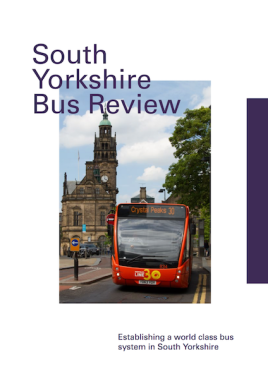
Finally this week, I’m handing the blog over to Chris Rubery, the Operations Manager at Weston-Super-Mare based Bakers-Dolphin to tell his story….

“On the 23rd March following my Scout promise to help other people at all times and to do my duty to country, making use of previous training and experience I started working for the ambulance service in Bristol. This was long shifts but four days on, four days off. It was important to me to be able to do something to help and this was on the frontline and I knew I could do this and still manage the few bits we are still doing at Bakers Dolphin.
All went well for the first couple of weeks, I was doing a mix of urgent care work on emergency ambulances alongside paramedics and also lots of patient transfers mostly with Covid patients from Southmead the Bristol Royal Infirmary, Great Western hospital Swindon and Gloucester Royal Infirmary. I knew going into this, that working so closely with many Covid-19 patients every day, despite always wearing PPE, there was always the chance I may get the virus myself and on 8th April almost inevitably I was infected with Covid.
I had a high viral dose so had it quite bad, temperature peaked at 39.3° – at which point you’re losing 5 litres a day, lost appetite, lost taste and stopped producing saliva for two days which is not very nice. The pressure from coughing fits burst the blood vessels in my eyes turning the whites pink and making my eyes feel bruised. I took Paracetamol to manage the temp and was drinking plenty. I was taking my blood O2, blood pressure, pulse, temperature twice a day. In our Scout group we have a nurse in all three sections, so I had Karen (after working her twelve hour shift in ICU) messaging me to discuss my stats and giving me valuable expert advice every day. We both knew that on day two my blood pressure dropped and she made me take lots more fluids. Lisa was also delivering supplies and checking up on me everyday. After four difficult days I’d fought off the virus, two days later I’d stopped blowing lung blood out my nose, but it left me with a lot of muck in my lungs which took another week to clear.
With the help of my scouting family I managed to recover at home. I then had another week where I could only potter around gently at home, I couldn’t do anything too energetic as I didn’t yet have the lung capacity. Everyday got better as the fluid cleared my lungs. The next week I was back at work on light duties, and the week after I was able to return to the ambulance service.
This work is a real privilege to carry out although sometimes very difficult as you are often helping people in their worst moments, then taking them into hospital for treatment, and occasionally you are with people in their final moments. I’ve also seen a lot of joy and people in their happiest moments. The scream of joy from a Covid recovered 78 year old who thought they would never make it out the hospital, but when you put them in the ambulance to go home and and they scream for joy when going home suddenly becomes real, or the honour of taking a young mum and her 1 day old baby who are both Covid positive, but in full health home, or taking a lady home on her 95th birthday or on a Thursday night driving the ambulance through two small Somerset villages at eight o’clock with all the village clapping, waving and cheering you.”
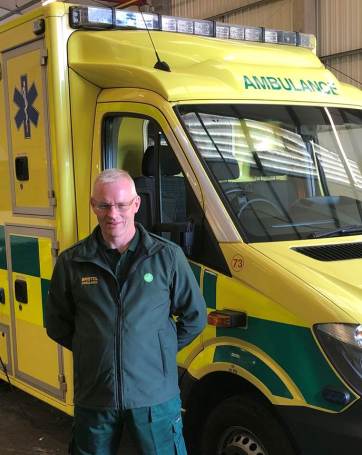
Brilliant work Chris. What a hero, among many.
Roger French




There is still a face mask border anomaly between England and Wales – presumably you could rip yours off halfway through the Severn Tunnel or at an anonymous point a few miles east of Welshpool, for example …
Safety signage on Cardiff Buses (and their website) is still fairly minimal: a couple of seats roped off near the driver, a couple of bits of tape on the floor near the door, and two or three signs on the windows advising social distancing. This is what it says on the website (there is also written content) though the notices on the bus are much less posh: https://images.cardiffbus.com/inline-images/Cardiff-Bus-Keeping-Clean-Social-01.jpg. Oh yes – and from Sunday the most convenient city centre stops will be closed to help people shop!
LikeLiked by 1 person
The current debate in Wales could be typified by Roger’s third (if my counting is right) zoom call of the week – namely that any funding for the industry stems down to “control”. Two of the local operators were in front of the Senedd EIS committee on Thursday, and any increase in service (because of the rush of shoppers!) that requires some start up funding seems to be delayed by that lack of a buses bill getting through the Senedd – and this therefore being the opportunity that TfW are taking to get it. (That’s available on Senedd TV if you want another one to watch Roger!) As with railways across the border, they are handily ignoring the massive waste of public funds going on something that people aren’t using at the moment (in it’s inflexible state) to give a proportionately smaller amount to a more flexible system.
It’ll be interesting to see how long the City Centre closure lasts – it’s nothing locals (remember, keep local in Wales for another two weeks) aren’t used to if they do venture out.
LikeLike
I think ‘damp squid’ should be ‘damp squib’!
LikeLiked by 1 person
Thanks! Updated.
LikeLike
With regard to the Go North East Flexi 5, ScotRail have had Flexi passes in place for a number of years. The Flexi 10 is the same price as a weekly ticket but is valid for 30 days. My wife used to work part-time so we would both go to work in the morning in the car but as she finished at lunchtime and took the car home, I would use the Flexi Pass for the train home.
LikeLiked by 1 person
Thanks Brian; that’s good to know.
LikeLike
If every rail journey is costing the government £100 then I must have saved them thousands by not having been on a train since 23rd March!
LikeLiked by 1 person
Me too!
LikeLike
The other face covering border anomaly will be for children aged 5-10 who need one in Scotland, but could legally remove it once they cross into England.
LikeLiked by 1 person
Of course with public transport it’s a subsidy but with road building and car driving it’s an investment.how much over the years have we paid private motorists to drive cars?where do you begin?the roads,car parks,cheap fuel, Lord Prescott’s bailout for jaguar, the police bills, the huge cost to the NHS of car accidents, the cost of the respitory damage the fumes are causing, the cost to fire brigades dealing with car accidents, the cost of parkway and park and ride to our public transportation infrastructure and the list goes on.a little strange cost to the then Virgin Cross Country was when the Coventry car plant shut VXC organized a trip to Weymouth for all the car workers and their families for free….did we see fleets of motorists turn up to give all the laid off rail workers over the years free trips to the seaside in their cars?! I remember a few years ago travelling from Hawes to Northallerton on the bus run by a company called Wensleydale railway co.which sort of filled the gap between United and Dales and District (and the infrequent Post Bus)and a women crashed her car into a hedge.all her fellow motorists drove past so she ended up with a free trip on the bus to Northallerton having not put a penny into public transport.
LikeLike
I have been rather puzzled by the visual of the bike carrying class 153. The internal view shows the racking covering an area equivalent to six windows. It would be reasonable to suppose that those windows would be panelled over, to avoid the risk of bikes accidentally brreaking the glass.
However, the external view seems to show six windows made of glass and four panelled over. If the bikes are in the glazed part of the train, surely the seated passengers aren’t in the panelled section. All rather curious.
We all know that artists’ impressions can differ from the finished products, but it would be good to know who gets the biggest portion of the unit, passengers or bikes?
LikeLiked by 1 person
One point that I picked up from the CILT South West webinar was the impact of different Social Distancing regimes on public transport. James Freeman revealed that his staff had taken a double deck bus and measured out the seat spacing for possible reductions of the present 2 metre social distance to 1.5m or 1metre. The conclusion of this test revealed that the capacity of a double deck bus with 1 metre spacing would increase from its current 20 passengers – to just 21, an increase of only 1 passenger !
Surprising, but true. So, still a very challenging constraint for bus operators.
LikeLike
I understand it needs to be 650mm (ie the distance between seat rows) to really make a difference, but that doesn’t have the same ring to it than 1 metre! With face coverings now mandated using each row makes sense.
LikeLike
You might be interested that the equivalent figure to the £100/rail journey for buses (outside London) is around £8.50/journey – based on 20 weeks’ funding of £1.25Bn (£167M + £30M + £254M Covid support + £796M pro-rata BSOG, supported services and concessionary fares) and £147M passengers (18% of £2.12Bn annual pax pro-rata for 20 weeks).
So at first sight, bus support is about 12 times more value for money than rail support – but that doesn’t, of course, take into account journey length. Using average rail journey length of 36km (Q4 2019/20) and bus journey length of 5km (which is a bit of a guess) gives subsidy of £2.78/passenger-km for rail and £1.70 for bus – so very much in the same ball-park.
Obviously all of these numbers have a wide margin of error, but its clear they aren’t sustainable for any length of time.
According to the Sunday Times, government policy is very much driven by polling and focus groups, so the sooner we get people to accept that wearing face-masks makes public transport a safe environment (whatever the spacing), the better.
LikeLiked by 1 person
Very interesting; many thanks.
LikeLike
Face Covering Confusion on School buses
There seem to be some confusion as to whether the legislation applies to School bus services and some Councils have decided it does not.
The only exceptions I am aware of are for certain disabilities and children under 11. The only possibility I can see is if the legal wording of the legislation says it only applies to public bus services
There seems to be no legislation though for School taxi transport
LikeLike
A little late coming to the party, but my generation haven’t got a clue what a metre is, nor any wish to learn. Could we also have these distances interpreted into English, particularly now free from Brussels rule.
LikeLike
Not difficult a yard and a bit on top! perhaps when Jacob Rees Mogg becomes PM you’ll be laughing….or move to the USA!
LikeLike
Megabus are restarting limited services from July 4th
Whether they will get any passengers is another matter. Given they are very low cost operation it is difficult to see how they will make money., I would have thought they would make lose. May be they are hoping passenger numbers will pick up quickly. If they do not they could be in trouble. It could be they will put fares up to offset it a bit
LikeLike
They, Megabus and by extension national express too, have a problem increase the fares and nobody will use them decrease them and the braver passengers will risk them.bearing in mind that the virus may return in autumn i can’t see how Megabus can survive as the market can’t bear 2 long distance bus operations,3 if you count flixbus going to places via the channel tunnel.megabus will probably end up selling up to national express?on a different note….how thick are the traveling public?very!I witnessed a man on a northern Middlesbrough to Newcastle sprinter,a 156, get up and shut all the windows down the end of the carriage he was in almost as if they want to get coronavirus.was it a cold day ?no 23c!
LikeLike
Megabus, sensibly, did an extensive survey with all their regular Passengers to at least determine likely use and to gauge any changes in future travelling habits. I gather the conclusion was that people were quite prepared to pay more for reduced capacity on the vehicles, and a glance at their website appears to confirm this. They are better placed than National Express, as have larger vehicles (and far superior seating I might add). Not all services are returning at this stage, but I sincerely hope they do as riding on double-deck coaches is infinitely better than looking at a seat back amid the smell of stale alcohol on most trains these days. And I enjoy free rail travel!
LikeLike